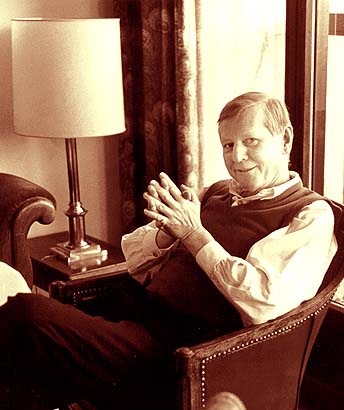|
 Years ago, Hans Magnus Enzensberger wrote a program for a machine designed to produce a number of poems exceeding the number of atoms in the universe: to be exact, the program allows for 10 to the power of 36 texts. It is based on a combination of 6x6x6 elements, or, more precisely, on the permutation of the combinations of the permutations of the combinations, resulting in a variation to the second degree:
Years ago, Hans Magnus Enzensberger wrote a program for a machine designed to produce a number of poems exceeding the number of atoms in the universe: to be exact, the program allows for 10 to the power of 36 texts. It is based on a combination of 6x6x6 elements, or, more precisely, on the permutation of the combinations of the permutations of the combinations, resulting in a variation to the second degree:
V“R[V‘r(n)lO=[nlK·····
Don’t be put off by the formula. Imagine instead six lines consisting of six elements, each of which exists in six different versions. (Those who have seen Raymond Queneau’s book Cent milliards de poemes, Paris 1961, will realize that the program is a three-dimensional improvement of Queneau’s two-dimensional model.) The variation of these elements is controlled by a random number generator.
It is one thing to write a program, and quite another to built the hardware needed to execute and to present it. In June 2000, the machine was presented in Landsberg, Germany, at a poetry festival. Measuring 5,65 x I meter and constructed by Solari Ltd. of Udine in Italy at a cost of US$200 000, it looks like one of the displays used in airports to announce departures and arrivals. When an onlooker pushes a button, the lettered flaps turn with a whirling noise and a six line poem appears. At the next push of the button, this poem disappears forever and another one is produced.
The program is not only designed to guarantee grammatically and semantically correct texts; it aims to create an illusion of ‘sense’, since it would be facile to settle for an arbitrary mix of words in a kind of neo-dada replay.
Enzensberger’s initiative is not meant to remain a monopoly of the author. This would be a self-defeating stance, since the outcome of his experiment is, anyway, impossible to predict, given the sheer number of possible variations. In fact, it is doubtful whether the poems produced by the machine do have an author in any traditional sense. It might just as well be argued that the person pushing the button is the ‘author’ of the poem.
Up to now, there exists only Enzensberger’s own program, which is in German. The machine is, however, capable of absorbing programs in any other language written in Latin characters. Enzensberger’s own account of the project is entitled Einladung zu einem Poesie-Automaten (Frankfurt am Main: Suhrkamp 2000. 74 pages), which, in English, would read Invitation to a Poetry Machine. Any poet interested is welcome to produce a program of his own which would be amenable to the soft- and hardware used.
In the meantime, the machine has been acquired by the Kunsthalle Würth, a museum in Schwäbisch Hall, Germany. The present owners would be interested in feeding the exhibit with foreign-language programs, and they are probably willing to give technical and possibly financial support to them.
Enzensberger has attempted to write a provisional English version of his own program. To give the reader an idea of the kind of thing the machine will have to offer, here is a sample produced on the basis of random numbers gathered from the last digits of 36 Berlin phone numbers listed on page 802 of the directory:
I miss you, hot girl! Don’t lock me into the ash-can, and help me to sleep no more.
Gorgeous treasures all over the place. The others might hardly notice it.
Sloppy confessions: ‘The public are to neurotic basically.’ Women are perfect.
Silent businessmen fill our lives, and common sense runs amuck.
I listen. My magic is perfumed with rage. I giggle, I sing:
Fear not our parents glowing in the dark! Downstairs the country is doing fine.
|

